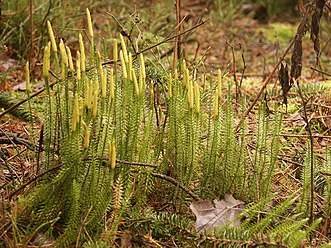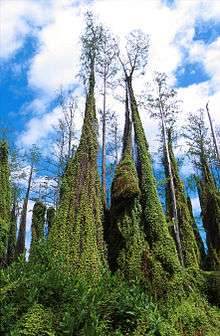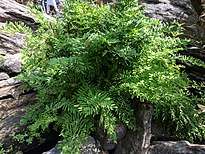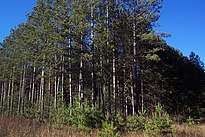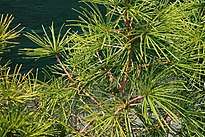Lava Formation
The Lava Formation is a Mesozoic geologic formation in Lithuania. Fish remains are among the fossils that have been recovered from the formation, although none have yet been referred to a specific genus.[8][9][10] The Jotvingiai Group Toarcian deposits were deposited likely in a shallow lacustrine basin or a near sea freshwater lagoon, with the other environment of the formation consisting of shallow marine conditions, seashore barriers and dunes, on a hot and humid climate.[11] Due to the abundant presence of deltaic sedimens (Including Plant fragments of Protophyllocladoxylon? sp.) on the upper part it is considered to be related to the retry of the sea level, as in the Polish equivalent formation, the Ciechocinek Formation.The climate at the time of deposition was strongly seasonal, probably with moonsonal periods.[12] There is a great amountof kaolinite content, being present laterally in the basin, decreasing and lefting space to increasing smectite to the south-west of the formation. On the other hand, there is a great amount of coarsest sediments, what consist mostly on sands.[13][14]
| Lava Formation Stratigraphic range: Lower to Middle Toarcian 180 Ma [1] | |
|---|---|
1.jpg) Strata on the Curonian Spit | |
| Type | Geological formation |
| Unit of | Jotvingiai Group[2] |
| Underlies | Skalviai Group |
| Overlies | Neringa Formation |
| Thickness | 45 m [3] |
| Lithology | |
| Primary | Sandstone and clay with a coaly admixture and the inclusion of wood remains.[4][5][6] |
| Other | Shallow, continental basins with sandy-clayey sediments deposited with traces of breaks and weathering. Upper part is dominated by argillaceous sediments. Cemented sandstones with interlayers of kaolinite-hydromica clays.[7] |
| Location | |
| Region | Curonian Spit |
| Country | |
Paleogeography
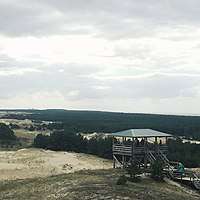
While most of Europe was occupied by sea, Lithuania has a dominated continental regime, which lasted about 32 million years.[15] The low elevation lands where flooded along the Toarcian rise and fall of the sea level, measured also on the Ciechocinek Formation, where the decomposition products were taken to separate depressions where they accumulated lagoon sediments, along with marine deposition of the sea basin lying on southwest of Lithuania.[15] The southwest was composed mostly by a series of deltaic successions, along with several unidentified water bodies.[16] The deposition of the formation shows a transition from deltaic to basinal facies at the west, where the sea shallow bays flooded the region, while in the north-east the land remained.[16] The Lava Formation shelf had a depth of 200–250 m. The climate was humid, slightly warmer than in average latitudes, with a drier climate periods.[15] In this climate, lush vegetation grew on the edges of the basins, leading to the formation of brown coal interlayers. Aalenian-Oxfordian marine activity led to changes, with the rise of the sea level, until it retreat back on the southwest near the Cretaceous strata.[15]
Spores
| Genus | Species | Stratigraphic position | Material | Notes | Images |
|---|---|---|---|---|---|
|
Chasmatosporites[17] |
|
|
Spores |
Affinities with the Gymnospermopsida. |
|
|
Perinopollenites[17] |
|
|
Pollen |
Affinities with the Gymnospermopsida. |
|
|
|
Spores |
Affinities with the Lycophyta. Abundant genus, related to freshwater deposits |
||
|
Hymenozonotriletes[17] |
|
|
Spores |
Affinities with the Lycophyta. Abundant genus, related to freshwater deposits |
|
|
|
Spores |
Affinities with the Lycopsida. Abundant genus, related to freshwater deposits |
||
|
Uvaesporites[17] |
|
|
Spores |
Affinities with the Lycopsida. Abundant genus, related to freshwater deposits |
|
|
Staplinisporites[18] |
|
|
Spores |
Affinities with the Bryophyta. |
|
|
|
Spores |
Affinities with the Lycopodiaceae. Most abundant Moss Spores on the Strata |
||
|
|
Spores |
Affinities with the Selaginellaceae. Relatively abundant |
||
|
|
Spores |
Affinities with the Selaginellaceae. Abundant and related with Deltaic facies |
||
|
Heliosporites[17] |
|
|
Spores |
Affinities with the Selaginellaceae. Abundant and related with Deltaic facies |
|
|
Cingulatisporites[17] |
|
|
Spores |
Affinities with the Pteridopsida. Relatively abundant |
|
|
Leiotriletes[17] |
|
|
Spores |
Affinities with the Pteridopsida. Relatively abundant |
|
|
Leiozonotriletes[17] |
|
|
Spores |
Affinities with the Pteridopsida. Relatively abundant |
|
|
Cyathidites[17] |
|
|
Spores |
Affinities with the Pteridopsida. Among the smallest and most difficult to found genera on the layers of the Formation. |
|
|
Pilosisporites[17] |
|
|
Spores |
Affinities with the Pteridophyta. |
|
|
|
Spores |
Affinities with the Schizaeaceae. |
||
|
|
Spores |
Affinities with the Marattiaceae. |
||
|
|
Spores |
Affinities with the Matoniaceae. |
||
|
|
Pollen |
Affinities with the Pinopsida. |
||
|
|
Pollen |
Affinities with the Pinaceae. Relatively abundant Pinaceae Pollen, appears specially on Kaolinite-abundant strata. |
||
|
|
Pollen |
Affinities with the Pinaceae. Relatively abundant Pinaceae Pollen, appears specially on Kaolinite-abundant strata. |
||
|
|
Pollen |
Affinities with the Pinaceae. |
||
|
|
Pollen |
Affinities with the Pinaceae. |
||
|
|
Pollen |
Affinities with the Podocarpaceae. |
||
|
|
Pollen |
Affinities with the Cheirolepidiaceae. |
||
Plantae
| Genus | Species | Stratigraphic position | Material | Notes | Images |
|---|---|---|---|---|---|
|
|
Stems |
Affinities with the Lycopodiaceae inside Lycopodiophyta. Moss, relatively abundant and relates with freshwater strata. Related to humid Floors |
| |
|
|
Leaves |
Affinities with the Lygodiaceae inside Schizaeales. A climbing Fern |
| |
|
|
Leaves |
Affinities with the Osmundaceae inside Osmundopsida. Abundant Ferns |
| |
|
|
Leaves |
Affinities with the Dipteridaceae inside Gleicheniales. Large Ferns, commonly found forming large colonies on near water environments. There are the most common flora on the Lava Formation. |
 Clathropteris | |
|
|
Leaves |
Affinities with the Dipteridaceae inside Gleicheniales. |
||
|
|
Leaves |
Affinities with the Matoniaceae inside Gleicheniales. |
.jpg) Phlebopteris | |
|
|
Leaves |
Affinities with the Marattiaceae inside Marattiales. |
||
|
|
Leaves |
Affinities with the Dicksoniaceae inside Cyatheales. Tree Ferns, relatively Abundant |
||
|
|
Leaves |
Affinities with the Ginkgoaceae inside Ginkgoales. Large to medium Arboreal trees, common on the Fennoscandinavian realm, but also on the Siberian strata. |
| |
|
|
Cones |
Affinities with the Piceoideae inside Coniferales. |
| |
|
|
Cones |
Affinities with the Pinaceae inside Coniferales. |
| |
|
|
|
Affinities with the Sciadopityaceae inside Coniferales. |
| |
|
|
Leaves |
Affinities with the Podocarpaceae inside Coniferales. |
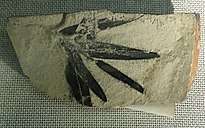 Podozamites | |
|
|
Leaves |
Affinities with the Podocarpaceae inside Coniferales. |
.jpg) Elatocladus | |
Actinopterygii
Color key
|
Notes Uncertain or tentative taxa are in small text; |
| Genus | Species | Stratigraphic Position | Material | Notes | Images |
|---|---|---|---|---|---|
|
Pholidophoriformes Indeterminate |
Nida, Curonian Split |
Teeth & Scales |
Bony fishes of the family Pholidophoriformes inside Pachycormiformes. Fishes of small size, the most abundant on the strata along the Toarcian European Realm. |
||
|
Semionotiformes Indeterminate |
Nida, Curonian Split |
Teeth & Scales |
bony fish of the family Semionotiformes |
||
|
Macrosemiiformes Indeterminate |
Nida, Curonian Split |
Teeth & Scales |
Bony fish of the family Semionotiformes |
||
See also
- List of fossiliferous stratigraphic units in Lithuania
- Toarcian turnover
- Toarcian formations
- Marne di Monte Serrone, Italy
- Calcare di Sogno, Italy
- Sachrang Formation, Austria
- Posidonia Shale, Lagerstätte in Germany
- Ciechocinek Formation, Germany and Poland
- Krempachy Marl Formation, Poland and Slovakia
- Azilal Group, North Africa
- Whitby Mudstone, England
- Fernie Formation, Alberta and British Columbia
- Poker Chip Shale
- Whiteaves Formation, British Columbia
- Navajo Sandstone, Utah
- Los Molles Formation, Argentina
- Mawson Formation, Antarctica
- Kandreho Formation, Madagascar
- Kota Formation, India
- Cattamarra Coal Measures, Australia
References
- Grigelis, A. L. G. I. M. A. N. T. A. S. (2007). Geology of Lithuania (Lietuva). Geology of the Land and Sea Areas of Northern Europe: A collection of short descriptions of the geology of countries and sea are as within the region covered by the, 1(4), 51-55.
- 1. Grigelis, A. (Ed.). 1982: Geology of the Soviet Baltic Republics. 340 pp
- Grigelis, A. 1994a. Jura. In: Lietuvos geologija. Grigelis, A. & Kadūnas, V. (eds.). Mokslo ir enciklopedijų leidykla, Vilnius, 139-153 [in Lithuanian].
- Šimkevičius, P. 2004. Triasas ir jura. In: Lietuvos Žemės gelmių raida ir ištekliai. Geologijos ir geografijos institutas, Vilnius, 81-90 [in Lithuanian].
- Paškevičius, J. 1997. The geology of the Baltic Republics. Lietuvos geologijos tarnyba, Vilnius, 387
- Lukševičs, E., Stinkulis, Ģ., Mūrnieks, A., & Popovs, K. (2012). Geological evolution of the Baltic Artesian Basin. Highlights of groundwater research in the Baltic Artesian Basin, 7-52.
- Zhamoida, V., Sivkov, V., & Nesterova, E. (2017). Mineral resources of the Kaliningrad Region. In Terrestrial and Inland Water Environment of the Kaliningrad Region (pp. 13-32). Springer, Cham.
- McCann, T., 2008. The Geology of Central Europe. Volume 2: Mesozoic and Cenozoic. The Geology of Central Europe. Volume 2: Mesozoic and Cenozoic. vol. 2. The Geological Society of London, pp. 881.
- LITHUANIA, L. O. J. I. (1994). Lower and Middle Jurassic. Geologija, 17.
- Wrona, R., Kröger, B., Berkowski, B., Malchus, N., Kowalke, T., Harzhauser, M., ... & Valiukevičius, J. (2004). Chongyu Yin, Stefan Bengtson, and Zhao Yue. ACTA PALAEONTOLOGICA POLONICA, 49, 4.
- Šimkevičius, P., Ahlberg, A., & Grigelis, A. (2003). Jurassic smectite and kaolinite trends of the East European Platform: implications for palaeobathymetry and palaeoclimate. Terra Nova, 15(4), 225-229.
- Simkevicius, P., 1998. Jurassic of the SE Baltic: Lithology and Clay Minerals. Lithuanian Institute of Geology, Vilnius
- Satkūnas, J., & Nicius, A. (2007, April). Jurassic geological heritage in Lithuania. In Lithuanian-Latvian field seminar: geological heritage of the Venta River Valley (pp. 12-18).
- Grigelis, A., & Suveizdis, P. (1993). Catalogue of Permian–Palaeogene Stratotypes of the East Baltic Area.
- Kavoliutė, F. (2012). Lietuvos gamtinis pamatas.
- Suveizdis P. Lietuvos tektoninė sandara, V., 2003.
- Venozhinskene,A.I. et al. (1971) Palynological indications of the Early Jurassic deposits in the southern part of the Balticum. (In:-Palynological Researches in the Baltic Soviet Republics. T.D.Bartosh, editor) [ Palinologicheskoe Obosnovaie Nizhneyurskikh otlozhenii Yuzhnboi Pribaltiki. (In-Palinologi Cheskie Issledovaniya v Pribaltike. T.D.Bartosh,editor) ] Trudy Ministerstvo Geologii SSR,Akademiya Nauk SSR,Zinatne P. 19- 30
- Venozhinskene,A.I. et al. (1978) Stratigraphy of Upper Triassic, (Rhaetian,), Jurassic, (Pre Middle Callovian), continental deposits of the western part of the southern Baltic area. (In: Phanerozoic Stratigraphy of the Baltic States Paleontological Assemblages, Structure and Composition of Sediments. V.S.Sorokin, editor) [ Stratigrafiya verkhetriasovykh (retskikh) Yurskikh (Dosrednekelloveiskikh) kontinental'nykh otlozhenii Zaladnoi Chasti Yuzhnoi Pribaltiki. (In: Stratigrafiya Fanerozoya Pribaltiki Paleontologicheskie Kompleksy, Stroenie i Sostav Otlotzhenii. V.S. Sorokin, editor) ] Trudy Ministerstvo Geologii SSR,Akademiya Nauk SSR,VNIIMGG P. 127- 138
- Feldman-Olszewska, A. (1998). Lower and Middle Jurassic. Palaeogeographical Atlas of the Epicontinental Permian and Mesozoic in Poland (eds. R. Dadlez, S. Marek and J. Pokorski). Pañstw. Inst. Geol.
Further reading
- Weishampel, David B.; Dodson, Peter; and Osmólska, Halszka (eds.): The Dinosauria, 2nd, Berkeley: University of California Press. 861 pp. ISBN 0-520-24209-2.
